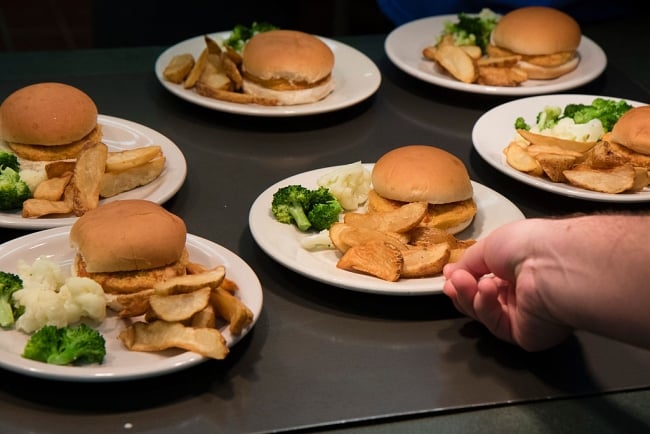You have /5 articles left.
Sign up for a free account or log in.

A patron takes a chicken burger at Ocean View Dining Hall, on the Southern Maine Community College campus in South Portland. A new study from NACUFS and FIU shows students want variance and choice in their dining halls.
Carl D. Walsh/Portland Portland Press Herald/Getty Images
Food and eating habits are critical pieces of the college experience, and students have been vocal on how dining facilities can improve or worsen their physical and mental health. A 2023 Student Voice survey by Inside Higher Ed and College Pulse found over one-third of students (37 percent) believe their campus dining facilities need improvement.
A new report from the National Association of College and University Food Services (NACUFS) found key themes in how students engage with dining facilities and what they expect from their institution in prioritizing their physical well-being.
Students emphasized a desire for accessibility, selection in food options and technology that aids in their dining experience. Dining programming should also consider students’ mental health and well-being and academic performance.
Methodology
Research for the report (available for $99) was conducted by Florida International University’s Chaplin School of Hospitality and Tourism Management. The college created an advisory board, led six focus groups, delivered quantitative surveys to students and completed interviews.
Surveys captured the opinions of 762 incoming college freshmen and first-year students to provide a glimpse of what future cohorts may expect or prefer from campus dining. A majority of students were commuters, with 29 percent living with extended family, 15 percent living alone off-campus and 5 percent living with nonfamilial roommates off-campus.
Accessibility. Easier access and greater availability of dining options were key themes among survey respondents.
When checking out, students prefer to grab items and check themselves out at a kiosk or use a touchless checkout that charges their account with automated sensors over interacting with a human.
Expanded operating hours of facilities is also important to diners. Just under half of Student Voice survey respondents (47 percent) want their colleges to prioritize dining halls opening earlier in the morning or later at night, and 39 percent prioritize dining halls being open continuously.
NACUFS survey respondents shared that they want breakfast to be served between 7 a.m. and 11 a.m., lunch between noon and 4 p.m. and dinner from 5 p.m. to 9 p.m.
Physical spaces. While in the dining facility, students value having the ability to use their personal technology, sit with friends and stay in the dining area before or after meals to meet with their peers.
As for programming offered by dining providers or facilities, students ranked mental health and well-being as the most important topic to feature, followed by learning about other cultures through food and thinking about food as fuel for academic performance.
Choices of dining. Students believe having a wide variety of nutritionally balanced food is most important in their food selection, followed by a variety of allergen-friendly foods, accommodations for different dietary needs and foods that satisfy religious needs.
Similarly, 40 percent of Student Voice respondents believe colleges should prioritize improving the variety and quality of flavors. Around 38 percent of students want to see fewer ultraprocessed foods and one-third want a greater variety of cuisines.
NACUFS survey respondents also prefer dining halls to vary their menu offerings regularly—daily or weekly if possible.
Tech desired but not always preferred. Students, when asked what technology was important to them in the dining facility, ranked purchasing food from vending machines when food wait times were too long as a top priority. This was closely followed by a preference for food prepared by a human instead of a vending machine–style robot.
Some college campuses have increased technology in their dining halls, offering mobile ordering, robot delivery and food lockers to increase access.
App considerations. Students ranked having a budgeting app or dining calculator as their top preference of dining program support technologies. Additionally, students would like to pay for their food with a mobile app over a physical card.
In terms of what students want in a campus dining app, top responses were viewing the menu, referencing dining locations’ hours of operation and accessing nutritional data of the food available.
If your student success program has a unique feature or twist, we’d like to know about it. Click here to submit.




